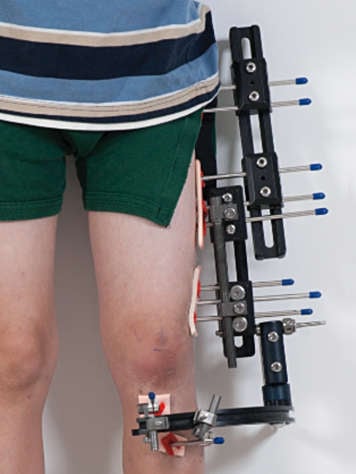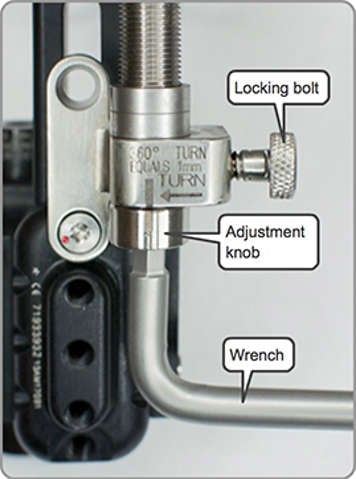
A monolateral rail is a type of external fixator that corrects limb length discrepancies. Sometimes it can be used to correct a deformity while also lengthening the limb.
The rail consists of a metal bar and may include a hinged joint, depending on the location of the limb length discrepancy and how severe it is. The hinged joint helps to keep your child's hip or knee joint stable while allowing it to bend and straighten.
Your child's condition will affect whether the surgeon uses the hinge and rounded piece of the rail that attaches below the knee (see photo).
The monolateral rail can sometimes be combined with the Taylor Spatial Frame during treatment. Your surgeon will discuss the best option with you and your child.
How is the monolateral rail attached to the limb?
Your child is fitted with a monolateral rail during surgery.
First, the surgeon will perform an
osteotomy to divide the bone. Then they use metal pins to attach the rail to the limb on either side of the division.
How does the monolateral rail work?
Design
The monolateral rail has two groups of pins that are attached to metal blocks on top of a black metal bar. On top of these blocks is a silver threaded distraction rod. Turning the rod pushes the blocks apart and gradually lengthens the limb.
Once the limb has reached its target length, the adjustments to the rail stop. The rail is left in place on the limb until the bone sets hard. This takes many months.
When the bone has healed, your child will need surgery to remove the rail. Sometimes a special rod is placed inside the bone when the rail is removed. This rod helps strengthen the newly lengthened bone and reduces the chance of it breaking.
Programmed adjustments
The surgeon will calculate a program for adjusting the monolateral rail after your child's limb reconstruction surgery. This calculation takes many things into account, including:
- how much lengthening of the bone is required
- how much more your child is due to grow
- the speed of your child's bone growth.
The surgeon will examine your child's limb and review your child's x-rays at weekly clinic appointments. Depending on your child's progress, the surgeon may need to adjust the program slightly during the period of lengthening.
How do I adjust the monolateral rail?
Adjusting the monolateral rail is very simple, as it has only one adjustment knob. You will be taught how to adjust the rail in line with the surgeon's program before your child leaves the hospital.
Starting adjustments
The adjustment knob for the monolateral rail is at one end of the threaded distraction rod. This is controlled by a metal wrench, which you will receive before your child goes home after surgery.

Five to seven days after surgery, you will start to turn the adjustment knob on the distraction rod to lengthen the rail.
- A full turn of the adjustment knob allows for one millimeter of lengthening. This is the usual amount of lengthening each day.
- You will spread out the lengthening by making a quarter turn of the adjustment knob three or four times during the day.
- You will know when the adjustment knob has made a quarter turn because it is divided into four quarters, which are clearly marked.
- Turning the adjustment knob a few times a day makes the lengthening process more gradual and less painful and leads to better bone formation.
- The direction the wrench turns depends on the set-up of your frame. Your child's
limb reconstruction team will guide you on the direction and amount you need to move the wrench.
Checkpoints for adjusting the monolateral rail
- A locking bolt on the side of the threaded distraction rod will move out and in as you make the turns. This special bolt stops the device from moving accidentally.
- Continue following the program for adjusting the rail until a member of your child's health-care team tells you otherwise.
Does my child need to take special care with the monolateral rail?
Your child does not need to worry about the distraction rod accidentally moving during the day or at night, as it is locked in place by the special locking bolt. Distraction (movement) can only occur when the rail is adjusted by the wrench.
The surgeon may decide that your child should not bear weight on the operated limb while using the rail. This decision will depend on the type of limb lengthening and reconstruction surgery performed on your child.
Typically, a child is only allowed to bear weight on the operated limb during the consolidation phase, when the newly grown bone starts to get hard. If your child is not allowed to bear weight, the physiotherapist will explain all the mobility device options that are available for them.
Return to limb reconstruction learning hub